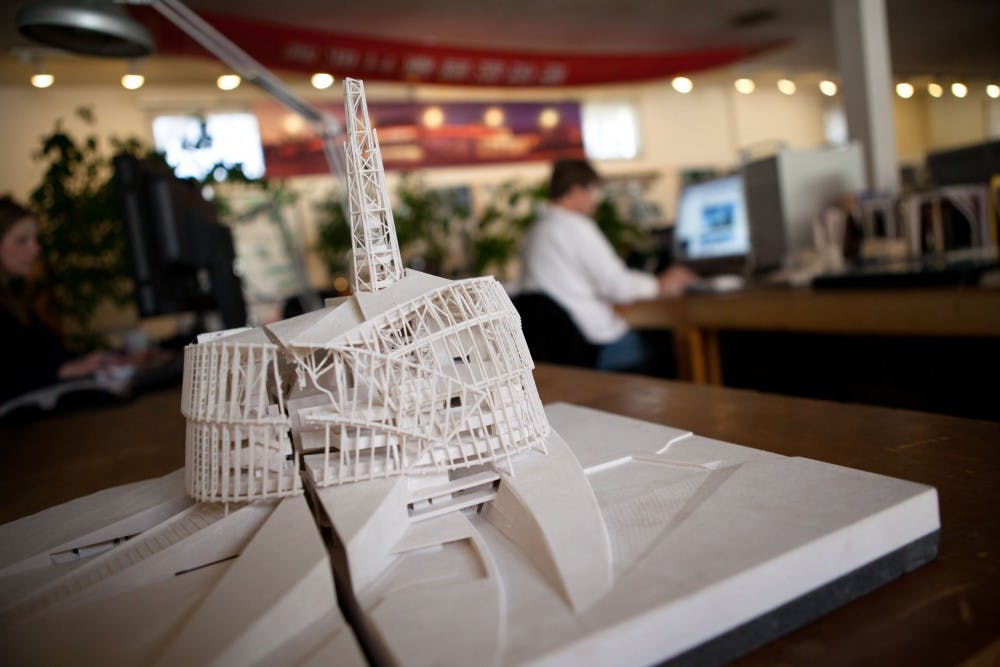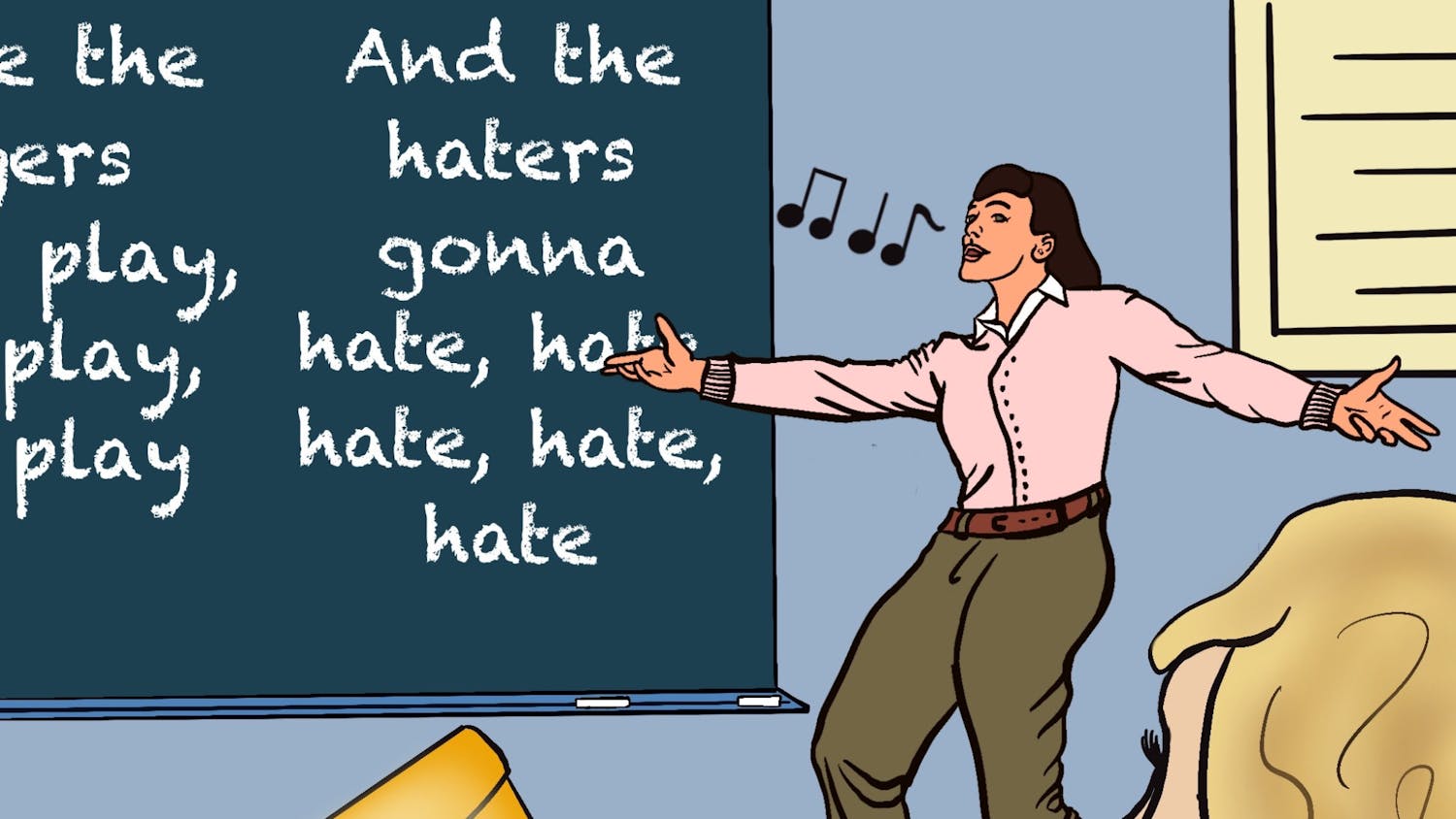World-renowned architect Antoine Predock has a sense of humor about his work.
At a presentation he gave Tuesday inside George Pearl Hall, which Predock designed, he showed a photograph of the building and the Frontier Restaurant across the street.
“Anybody who saw that, which would they like better? The big, scary-ass modern building?” Predock asked the packed lecture hall, which responded with a chorus of laughter.
“That’s fine,” he said. “I like the Frontier better myself.”
George Pearl Hall was built on a “cheapo” budget, Predock said during the presentation, and later reaffirmed this to the Daily Lobo. He said that he used his monetary constraints as an excuse to leave electrical wires and other internal elements of the building exposed.
“I like the way that the building tells a story of construction,” he said. “It’s just a naked building. And there are two reasons for that. One is for reasons of instructional authenticity, but also money.”
Predock’s presentation coincides with the opening of “Roadcut: The Architecture of Antoine Predock,” an exhibit at the UNM Art Museum.
Predock attended UNM as an architecture student and has put in more than 40 years of architectural work. He’s the recipient of prizes, including the American Institute of Architects’ Gold Medal, one of the most prestigious awards in the architecture community. He designed buildings in Albuquerque, including Bratton Hall at the Law School and the Albuquerque Museum.
The exhibit, like Predock’s lecture and his buildings, incorporate elements of the surreal and the chaotic.
A display case in the “Roadcut” exhibit offers an example of Predock’s style. It contains seemingly random objects, like a Day Pass to the 2008 Beijing Olympics and a catcher’s mitt with Predock’s name stitched into it, presumably a souvenir from Predock’s work designing the San Diego Padres’ ballpark.
In the presentation Predock gave, he connected seemingly random elements to the work of architecture, telling the audience his work is influenced by everything from the jet streams of fighter planes to the imposing walls of Chaco Canyon.
He said Southwestern landscapes, like Chaco Canyon, have always had a huge affect on architecture.
“Architecture is landscape in drag,” he said. “New Mexico architecture is about big walls. Big, unapologetic, nasty, in-your-face walls.”
Get content from The Daily Lobo delivered to your inbox
And these walls were a guiding theme in his work on George Pearl Hall, he said. Predock then chastised the architecture students in the audience for their failure to make creative use of the walls, which he views as an opportunity for expression.
“Why don’t you use my walls for projections?” he asked, and someone shouted a reply: “They locked us out!”
But Predock didn’t accept the excuse.
“You’re lame! You’re obviously lame!” he yelled, seemingly only half in jest. “I worked my ass off to bring that to you, and you don’t use it!”
If it seems like the presentation wasn’t really about the technical side of architecture, that’s because Predock didn’t intend it to be. He was more interested in connecting other artistic and cultural influences to the discipline of architecture — like comparing the art of dance to the discipline of designing a building.
“Anything’s performance. This is performance tonight,” he said. “It’s not about architecture. It’s just a chance for me to spout off in front of a captive audience.”
And a performance it was, sort of like an improvised stand-up comedy routine with a shifting background slide show of random stuff that interests Predock.
There was, of course, plenty of audience interaction, and even a guest celebrity — Don Schlegel, one of Predock’s early mentors at UNM. Predock took the opportunity to single him out as he entered the auditorium about 15 minutes late and sat on the staircase after failing to find a seat.
“(Schlegel) was a professor that would say, ‘Get the hell out of architecture! Dumb shit!’ He kicked me out of UNM … I just saw him walk in,” Predock said, shining a laser pointer above Schlegel’s head.
“Roadcut,” too, is about more than just blueprints. The
exhibit features sketches, collages, and two actual motorcycles — a Vincent Black Shadow and a Ducati, like the one Predock was riding when he crashed and broke his collarbone last week, forcing him to give his presentation with his left arm in a sling.
Motorcycles were a recurring theme in the presentation, and he referenced journalist Hunter S. Thompson, taking issue with Thompson’s assertion that, “If you rode the Black Shadow at top speed for any length of time, you would almost certainly die.”
“I’m still alive,” Predock said. “(Thompson) wrote a lot about Vincent Black Shadows, but he didn’t know squat about them. You can tell he never actually rode one.”
Predock ended his presentation on the theme of injury, showing a picture of himself skiing and pondering aloud why he continues to practice the sport.
“I don’t wanna get hurt. It really hurts when you break your ribs,” he said. “But whatever keeps me doing that is what makes me keep doing architecture.”






